Growing Garlic in Pots & Containers at Home
April 15th, 2021 | Categories
Growing garlic at home in pots or containers is a great way to grow a nice crop of fresh garlic when space is at a bit of a premium, or even when it isn’t. Pot grown garlic will do very well and still produce a good crop of fresh garlic without all the extra work of preparing a site in the ground for planting. What makes it even better is that growing garlic in pots or containers is a relatively easy process which means gardeners of all skill levels and experience can have a go. The particularly great thing about growing garlic in pots or containers is that you aren’t actually planting in the ground, or even have to place the pot or container in a garden; they can be grown on balconies or other areas when there is little to no actual garden space.
The humble garlic has exploded in popularity over the last few decades to become a fundamental staple ingredient in dishes in the UK. Prior to this, it was seen as something foreign or exotic to our plates, and palates, but now it is so popular there’s even a National Garlic Day – April 19th! Garlic is widely used as an herb or a spice to add something extra to a dish, but garlic is botanically a vegetable. Specifically, it’s a vegetable that’s part of the allium family, which means that it’s related to onions, shallots and leeks. Unlike its relations, you most certainly would not eat a garlic raw though, though no doubt some do!
Garlic is typically crushed, spread, roasted, blended, or chopped to add to dishes. It’s also extremely popular with new and experienced gardeners alike, great also for families with young kids, because it’s really easy to grow good garlic in the UK, and an exceedingly small space can still produce a decent yield. It primarily just needs good tending and a warm sunny site. Garlic also generally keeps well which means anything unused can be stored away for several months. This guide is specifically for those who wish to grow garlic in pots or containers at home. We’ll cover everything you need to do to from preparation through to harvest and storage. If you want to grow garlic in the ground at home, we have covered that in a different guide here.
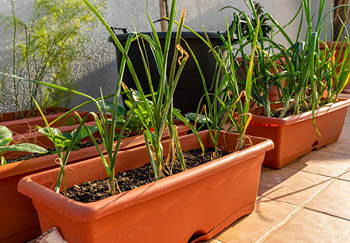
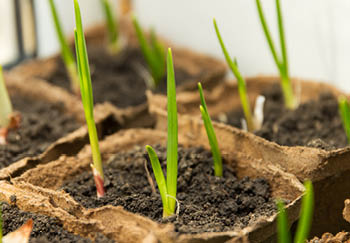
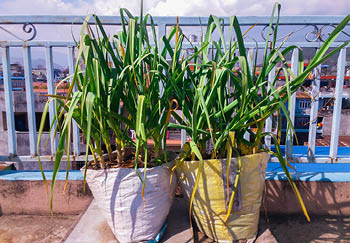
Why Grow Garlic in Pots or Containers?
Growing garlic at home in pots or containers is a brilliant way to grow garlic at home if space is limited or if you don’t want to grow in the ground. Why specifically garlic though? Well, garlic is extremely easy to grow – even for total beginners – and rather undemanding as far as growing goes. It’s also an unbelievably versatile vegetable that has grown in popularity to become a staple ingredient in meals up and down the UK. It stores well too, lasting for up to a few months, though certain varieties are better suited for storage than others.
Garlic is also remarkably good for us in a balanced diet. It is jam-packed with B and C vitamins, manganese, selenium, iron, copper and potassium. When crushed or chopped, garlic produces an enzyme called allicin, which has been found to reduce inflammation and give antioxidant benefits. All that goodness goes to our hearts, joints, brains, helps with digestion, colds and flus, muscle aches, and more. We think you’ll agree it packs quite a punch for its size, and we do not just mean the pungent aroma! And let’s not forget the bragging rights for growing your own veg. That trumps all surely. The freshness, taste and variety you can achieve at home that is lost from the mass-grown store-bought garlic. Supermarket garlic is sold as fresh, but it’s actually not because it has already been dried.
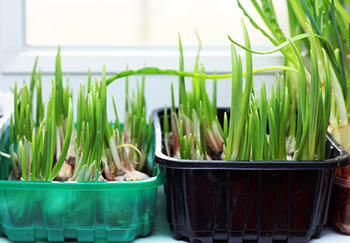
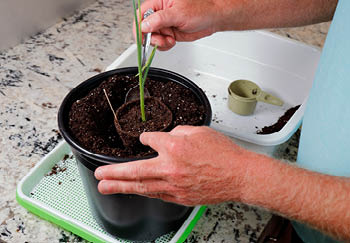
What Variety of Garlic Should You Grow in Pots?
Before you plant, consider the type or types of garlic you want to grow in your pots or containers. Would you like to grow for size? Or how about flavour? Maybe you want longevity mostly? Perhaps you want a really bountiful cropper? Or do you have a specific use case for a meal in mind? Whatever variety you choose you’ll generally follow the same process of growing in pots and containers so don’t worry about having to drastically alter the plan.
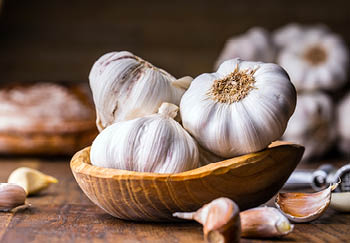
Hardneck vs Softneck Garlic
There are two main types of garlic: hardneck and softneck. Hardneck varities will produce garlic plus an edible flower stem as they grow – also named a ‘scape – which can be chopped up for use in salads. They’re a good choice if you want a little more use from the crop. Softneck garlic varieties don’t produce the scape. However, a positive characteristic here is that the bulbs can generally be stored for longer than hardneck varities. Softnecks generally mature quicker too.
So, there are some pros and cons to consider between both types, not huge ones by any means, but it pays to be aware of them. Since garlic is quite easy to grow, requiring little actual space, why not grow both types in several containers to keep your options open? Something to keep in mind is garlic will always be grown from bulbs, as it is quite hard to produce viable seed for use at home. So, you’ll be buying bulbs from a good garden centre. Whatever variety you choose to grow just be sure of their specific type, when to sow, when to harvest, and any individual needs or characteristics they may have.
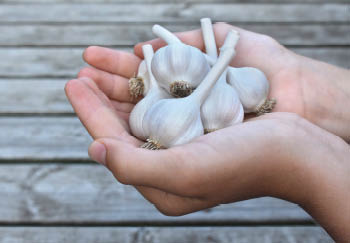

Varieties of Garlic to Grow in Pots
If you’re a newbie, you’d be forgiven for thinking all garlic varieties are like the ones you find in supermarkets. Our shops are not known for offering diversity across vegetables. Whether it be onions, potatoes, tomatoes, carrots – most if not all veg – you get one or two choices and that’s it. It’s about commercial efficiency and longevity at the expense of choice and freshness, and that’s fair enough. But with just a relatively small amount of effort you can open your horizons to lots of different varieties that will be fresher, that are better for you, will taste better, and ultimately works out cheaper in the long run.
Red Duke Garlic (hardneck)
It has a lovely purple striped appearance and produces large cloves. It is one of the strongest flavours of garlic around and is a good storer.
Solent Wight (softneck)
This garlic comes from the Isle of Wight and is well suited to the UK climate. It’s got a great balance of flavour – medium to strong – and also keeps well so you can store and enjoy months later.
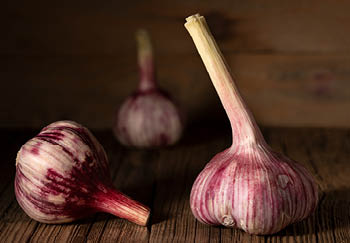
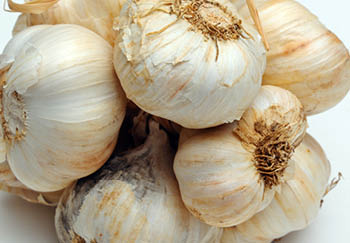
Don’t Plant Supermarket Garlic
Don’t bother with trying to plant garlic cloves from a supermarket. It’s not worth the effort. Supermarket garlic are generally cultivated in different parts of the world where the climate is completely different. Additionally, while they are treated as they grow, they are not held to as strict standards garlic specifically for planting is, and so may carry diseases that do not affect humans but are those that garlic are susceptible to. Always buy certified disease free, from any good garden centre. The same goes for any starting seeds, vegetables or plants.
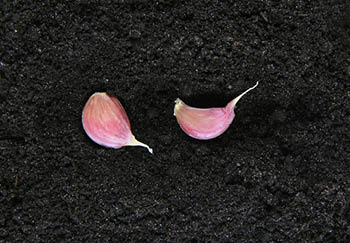
Choosing Hardneck or Softneck
There’s no major concern if you choose either, or both types of garlic, to grow in your containers. The only thing you need to be aware of is your planting and growing timeframe, which may be different depending on the type of garlic you choose, and, if you are placing your containers indoors or a in a greenhouse. More on that next.

General Growing/Harvesting Timescale for Garlic
It’s worth pointing out again that garlic is typically always grown from bulbs, because producing viable seed for use at home is quite difficult. When you go to buy, just remember this to avoid any confusion. So, when it comes to planting your garlic in the UK generally you can generally plant from autumn to spring, say late October/November in the autumn to late March/April. They are best planted in the autumn as this will produce a better crop. Top tip: experienced garlic growers always plant before Christmas for the best results both in size of bulbs and in cropping. Keep an eye out for whether the bulbs are being sold for autumn or spring planting, as it may affect your results if you plant an autumn bulb in the spring and vice versa.
Generally, garlic will be ready for harvest sometime from May to September/early October. This holds true for garlic planted in the autumn too, though you might find it comes to harvest a lot earlier in the season vs spring planted varieties. Please note though that some varieties will crop sooner so just be aware of the specific growing timeline of your chosen garlic variety. Weather and growing conditions will also be factors to consider. Likewise, if your containers will be in a greenhouse or indoors, then you will likely be able to plant sooner, and achieve a faster harvest. Consider all the factors and get a good idea of your plan ahead of time.
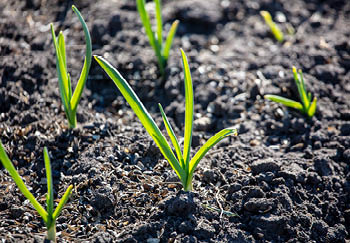

How to Start Growing Garlic in Pots at Home
Now you know some more about garlic you’re ready to get started growing your own at home in pots, or containers at home. It pays to know what to do in advance so read through our guide, get up to speed, and then when you’re ready to go, get started! Remember, you’ll be starting off from bulbs bought from a good garden centre.

What You Will Need
Here are some key tools and items you’ll need to have to grow garlic in containers or pots:
Containers or Pots
An obvious one right. Ensure you have the right containers or pots for the job. A small container or pot won’t be suitable for growing garlic, it would be for a single plant, but for a decent crop you’ll be growing several at least. If it’s a pot you want to grow them in, make sure it is large, approximately 30cm deep and a two to three feet wide. Or use several smaller pots. If it’s a container, typically you can find ones to suit in terms of size far more easily, at better value for money too. You can even build them yourself with a little effort. No matter what you have ensure sure it has good drainage.
Just to emphasis the point, you’ll need multiple plants to produce a good crop, so this will in turn affect the size and or number of containers. Generally, garlic are grown in rows and the wider they are spaced from one another, and other rows, the larger they will grow. Placing them a little closer is OK, they will just produce smaller onions. Don’t crowd them with one another though as it’s better for their development and for disease control. Aim for 10-15cm spacing on all sides, or if you have long containers, in a row with each bulb spaces 10cm apart.
Softneck or Hardneck Bulbs
Purchase your garlic variety from a good garden centre.
Compost
Your container needs a good quality compost, preferably one that is suitable for growing vegetables or specifically garlic. A good quality general vegetable and potting compost will suffice and it’s easy to find bags in any garden centre. You can also add some suitable grit, then when it’s all mixed up you’ll have a good mix of soil that’s able to drain well.
Hand Fork
For digging and loosening the compost and soil mix as you pour it into the container. The soil should be nice and loose to make it drain well and also to allow your garlic to establish its root network.
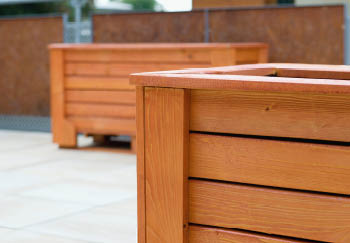

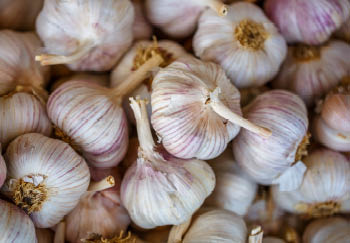
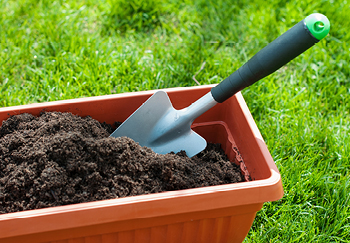
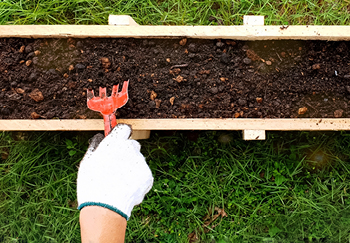
Growing Garlic from Bulbs
Unlike other vegetables that may be grown from seed, garlic isn’t typically grown this way because it’s hard to produce viable seeds for use at home. So, this cuts out a lot of preparatory work developing seedlings and means you simply buy the bulb variety you want, when they are available from a good garden centre. You may wish to prepare your containers or pots ahead of time though, details coming next.
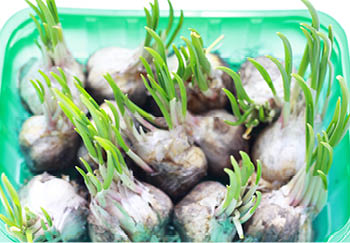
Consider the Site & Prepare the Container
Garlic needs a warm, sunny spot, that has full sun, with fertile and well-draining soil. Choose a suitable area for your containers or pots that offers this. Also, if planting in autumn you need to ensure that throughout winter the site does not get too wet as this will increase the chances of rot and disease. It might be quite difficult to move the containers when they are filled with soil so consider this beforehand. The great thing about container growing garlic is the ease of preparing the compost/soil. You just buy the right stuff, mix, and you’re already there. By comparison, if you were planting in the ground, you’d have a lot more work to do digging the ground and weeding the area. An added bonus is that you can be sure the soil mix is free of disease.
Remember (and to give you an idea of how large your pot or container needs to be, or how many you need) you will plant each garlic clove 10cm apart in a row or row, and each row in turn should be about 30cm apart from one another. This will give your garlic enough room to grow. Weeds can even work their way in too, so having space makes spotting them and removal easier. So, consider this, along with how many cloves you have or wish to grow, and this will tell you how large your container needs to be, or how many you need.
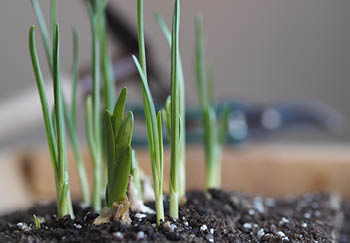
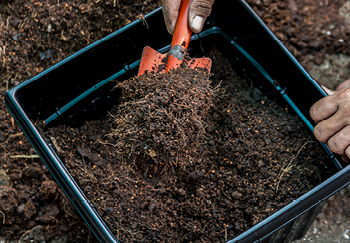
Sowing and Planting Garlic Cloves
When your potting/container soil is prepared and the time is right to sow your garlic cloves (depending on the type you have) carefully start removing the cloves from your bulbs and push them into the soil, about two to three inches deep, ensuring the pointed end points upwards. Gently cover with soil a little over the top of them and water in well being careful not to over-water.
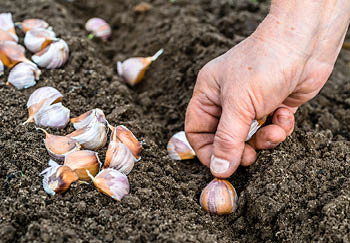
Growing
You’ll be more than pleased to know that garlic isn’t a demanding plant by any means. It doesn’t need a lot of watering or feeding. Growing garlic or any vegetable for that matter in containers can increase their water requirements because there’s no extensive ground network to draw from. It can be helpful to your onion plants to keep the soil moist, but not wet. More so during long dry spells. But that’s about it. Stop watering when you see the leaves turning yellow. The main thing to keep on top are weeds which can still sprout up in containers, but the chances are lower.
The garlic plant isn’t very large, so it doesn’t create a lot of shade, and that in turn means it can be quickly smothered by fast growing weeds nearby. Keep an eye and dig them out if they appear. If you see any bulbs that have been uprooted for whatever reason (wind or animals), don’t worry, garlic is hardy enough that this can be rectified easily by pushing them back into the soil. With hardneck varieties, you may see them start to flower, but pick these before they fully form so the plant focuses on growing the garlic bulbs. Continue to keep an eye on your garlic until it’s time to harvest.
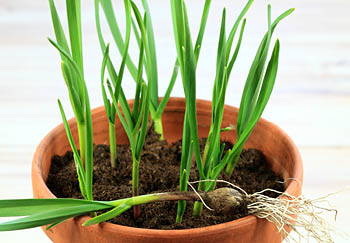
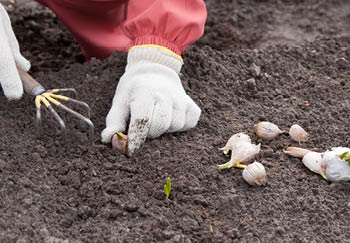
Harvesting your Garlic
As mentioned earlier, when to harvest your garlic will depend on your chosen onion variety, weather and growing conditions. Generally, though, autumn-sown garlic may be ready around June, and spring-sown garlic around the end of July/August onwards. You’ll know when it’s the right time to harvest because the leaves will droop and turn yellow to brown when they’ve stopped growing. At this point they should be big enough to harvest and use immediately if you like. To harvest, gently loosen the soil, a fork is best, and then lift the garlic from the soil. Watch out for cutting the bulbs with your fork as this will reduce their storage longevity or render them unable to be stored at all.
Next, gently brush off dirt and then allow the garlic time to dry out somewhere for two to three days, left out on a tray in the sun somewhere. Any remaining dirt should be brushed off again.

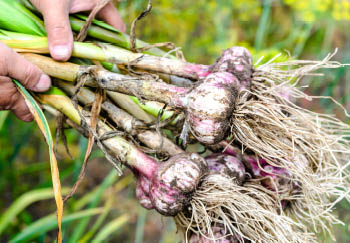
Storing your Garlic
Once the garlic has been dried, separate the garlic you will use from those you will store. You can store them loose in a string sack, in a cool, dry and dark place. Alternatively, you can opt for a traditional way of keeping them together by plaiting the foliage to make a string of bulbs. Grown well and stored correctly, they should last for months. Any damaged bulbs should be discarded. Remember, softneck varieties generally store better than hardneck varieties, so plan to use these ones first if you have grown any.
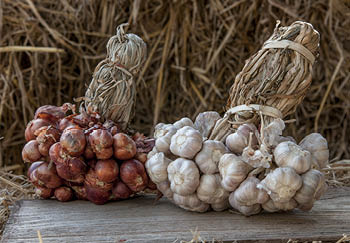
Common Problems to be Aware Of
Like any vegetable garlic can suffer from some problems, but with container growing the chances for problems are much reduced. Here’s a run through of what to know and watch out for though:
Leek Rust
But garlic isn’t a leek you are saying rather confusedly. We know, it’s just because leeks are from the same family and this is the name for the fungal disease that causes bright yellow spots on the leaves. It exacerbated by wet spells and overwatering so watch that watering! Unfortunately, there’s nothing that can be done once there. If it’s mild, the garlic won’t be harmed. If it’s bad and all over the leaves then remove the garlic and dispose. Good spacing when planting will ensure it doesn’t spread amongst the other garlic plants. Be sure not to use the potted soil again if this appears.
Onion White Rot
Similar to above with the naming convention. This is visible in the form of a dense white fungal growth around the roots and base of the bulb. Unfortunately, there is no cure or remedy, and the only real option is to dig up all traces then destroy them by burning. This site should not be planted on again. This shouldn’t really appear in your containers if you are taking care of them well.
Birds
By far the most annoying problem are birds. They will happily eat your seedlings, buds, leaves, the entire thing. Prevent them from getting to your crop by simply covering with suitable bird netting. Of course if they are stationed inside a greenhouse or garden structure then rest easy knowing no bird can reach.

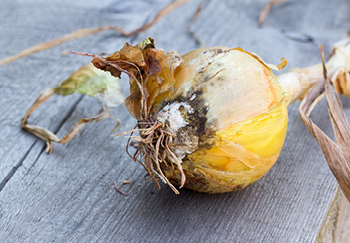

Your Very Own Home-Grown Garlic from Containers
And that’s it! Super easy right? Garlic is great to grow in containers at home if space is at a premium or you just can’t be bothered digging up the ground. Containers will still provide a bountiful crop for you to use and store for future months. What will you do? Why not make your own naan bread and spread some of the garlic over it? Or bung some in a roasting tray with chicken and lots of root veg? Whatever your aim, we hope you’ll give it a go growing your own.

Useful Links
- Shop Online for Garlic Sets
- Growing Garlic from Clove to Harvest (Article)
- Growing Onions from Seed to Harvest (Article)
- Growing Potatoes from Planting to Harvest (Article)
- Growing Chillies from Seed to Harvest (Article)
- Guide to Growing Tomatoes in Pots (Article)
- Grow Your Own Herbs (Article)
- Grow Your Own Strawberries (Article)






